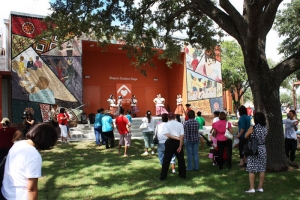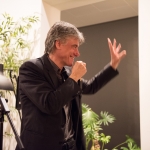Appreciative Practitioners and The Power of Discovery
Something new always emerges, something worth investigating! –Wick van der Vaart
Keith Storace
Of all the things my father shared with me throughout the many creative hours we enjoyed together, his most inspiring and enduring words continue to resonate with increasing meaning: “Do your best; give now; be in community.” The wisdom with which he embraced his talents, shared his skills and engaged with others emphasised the importance of relationship – and no less in the workplace.
Ultimately he understood and appreciated that how we interpret the world around us, what we ask of it and
what it asks of us in return will influence how we engage with it and the consequent discoveries that emerge. An appreciative perspective began to sit naturally with me, as it had done with my father, when I understood that at the very heart of this way of being lie three life-enhancing considerations:
- Allow yourself to be inspired so the best in you can be realised;
- Allow yourself to dream so who you are and what you can give will be clear;
- Allow yourself to be with others so the future can be shared and strong. At its very core, Appreciative Inquiry invites us to embrace these considerations and allow ourselves to be imbued with the promise that “something new always emerges, something worth investigating!” (Van der Vaart, 2017)
Discovery breeds discovery (by Whitney Fry)
Discovery breeds discovery and almost always begins with what we ask or what we are being asked. It is no surprise that it is a key aspect of the Appreciative Inquiry (AI) 4D model incorporating Discovery, Dream, Design and Delivery
(Watkins, Mohr and Kelly, 2011). It is also no surprise that AI practitioners always emphasise the power of discovery, and how it is a multilayered and expansive experience. The extent to which discovery can contribute to one’s personal and professional narrative is expressed in Whitney Fry’s AI story that featured in the May 2016 issue of AI Practitioner. Working toward the prevention of gender-based violence among male refugees living in East Africa, Whitney shares the power of storytelling and the inherent discoveries that emerge:
I love seeing people’s faces light up when asked what they appreciate about their community or organization, as well as the transformation that takes place when one tells a story and realizes that the answer lies within themselves or their community. Furthermore, with each AI experience, I also learn something new: from the art of the right question to the power of story telling to the transformative potential of dreaming (Fry, 2016).
A global health consultant based in Nairobi Kenya, Whitney works toward promoting transformational change in complex environments. One of the most profound discoveries offering insight and foresight was the way Whitney experienced AI in the context of her faith, hope and gratitude:
As a follower of Jesus, AI complemented my world view and provided a practical application of gratitude: seeing positive change in unexpected places. AI in many ways was the reset button to my “hope meter,” and my vision suddenly opened from a myopic perspective of deficit details to the bigger picture of possibilities.
Whitney Fry, 2016
Discovery and the positive core (by Judy Janse van Rensburg)
From an appreciative perspective, it would be difficult to imagine discovery upon discovery, “the bigger picture of possibilities” as Whitney expresses it, without the acknowledgment and focus on a positive core. From all the stories shared with me over the years by AI practitioners and those who have engaged in AI workshops, it is the “positive core” at the centre of the 4D model that is coveted for all it is and can contribute to the ongoing transformation of individuals, teams and organisations.
I often smile at the thought that I have never experienced an organisation that didn’t have a positive core to work from, to build on, and to base its future on. It is the driving force at the heart of participants’ experiences continuously encouraging discovery time and time again. The power of discovery is evident in the way employees appreciate it as a ‘Eureka!’ moment that compels them to dream, design and deliver.
The discoveries that emerge when the positive core is embraced is an appreciative experience shared by Judy Janse van Rensburg, founding director of Irock Coaching based in Port Elizabeth South Africa. In the November 2016 issue of AI Practitioner, Judy highlighted the importance of entrepreneurs understanding that discovery emerges through the positive core giving back
to individuals and organisations an indelible appreciative perspective that empowers them to see solutions that allow them to organise the necessary changes.
Appreciative Inquiry gave hope to entrepreneurs as they focused on their positive core. Getting to know themselves as entrepreneurs empowered them to see new possibilities and take positive action. Understanding what “gives life” to a system could mean the difference between success and disaster. When entrepreneurs are aware of what gives them life and when they are at their best, they can harness that knowledge and create magic. When they are able to review their best experiences of dealing with clients, they become inspired to make more effective and strategic sales calls.
Janse van Rensburg, 2016
The wonder-filled AI experience of discovery (by Claudia Gross)
Discovery that emerges from the positive core is almost always sparked by the questions we ask. Dr Claudia Gross, an organsiational development consultant based in Cairo, Egypt presents a good example of this. In the February 2016 issue of AI Practitioner, Claudia’s article, “My AI Journey: From Learner over Practitioner to Contributor”, emphasises a wonderful (and wonder-filled)
AI experience of discovery at the heart of her AI journey:
During my AI introduction training, I experienced the magic and power
of the AI interview myself. Ever since, I’m eager to provide a similar experience for other persons. In the discovery phase of team building retreats, I love asking this question [What is the most memorable experience of you working in this team?] to connect the participants
with their team at its best.
Gross, 2016
“Diving deeper”, as Claudia writes of her team-building sessions, has enabled all involved to engage in shared narratives that unveil the strengths, values
and desires of an envisioned future for the team. Throughout the collective sharing and developing of ideas, there is always an undeniable deep insight
and connection that emerges and is embraced for all that this level of discovery promises. This promise is also the lived experience of the work Ann Hilbig has been involved with at BakerRipley, a pioneering community development organisation in Houston, Texas, USA. In her role as senior vice-president of programming and evaluation, Ann emphasises in the November 2017 issue of AI Practitioner how discovery and change begins with the first new question:
The road to change began by questioning our questions, and discovering that the answers we needed lay in a new way to ask. We asked first not what was wrong with the neighbourhoods we serve but what was right. From the answers came a new beginning for our neighbours. And we
used the same approach internally to change and strengthen our own organization. So this is a story of change that began with a first new question: What is right? – and how we created a transformational new framework called Appreciative Community Building. Hilbig, 2017
Discovering the undiscovered (by Ann Hilbig)
Discovering the undiscovered – what people value and care about most – became pivotal to the way in which Ann and her team generated the kind of life-giving properties of AI that communities would ultimately benefit from and further develop:
We knew the people we serve possess strengths and talents that went undiscovered when we only assessed what they needed. We saw people with amazing inner resources and abilities, and recognized they were seeking opportunities to fulfil their aspirations. (Hilbig, 2017)
The focus at BakerRipley on discovering the resourcefulness within communities and individuals highlights the way in which this attention strengthens resilience and ensures sustainability. When working from the perspective of being resourceful, we are looking for and discovering other possibilities that may be available as suitable solutions, as well as discovering more about our communities and ourselves at the same time.
Appreciative Inquiry at its best is undeniably a discovery of self and other where everything we have to offer is seen and put to work so that our future can be shared and strong.
REFERENCES
Fry, W. (2016) AI: Positive Change in Unexpected Places. AI Practitioner, 18(2), 74–75.
Gross, C. (2016) My AI Journey: From Learner via Practitioner to Contributor. AI Practitioner – International Journal of Appreciative Inquiry, 18(1), 68–69.
Hilbig, A. (2017) Appreciative Community Building. AI Practitioner – International Journal of Appreciative Inquiry, 19(4), Number 4, 110–115.
Janse van Rensburg, J. (2016) AI: Creating Magic for South African Entrepreneurs. AI Practitioner – International Journal of Appreciative Inquiry, 18(4), 60–61.
Van der Vaart, W. (2017). What Really Matters. AI Practitioner, 19(4) 92–93.
Watkins, J. M., B. J. Mohr and R. Kelly. (2011) Appreciative Inquiry: Change at the Speed of Imagination.
(Second Ed.) San Francisco: Pfeiffer.




 The road to change began by questioning our questions, and discovering that the answers we needed lay in a new way to ask those questions. We asked first not what was wrong with the neighbourhoods we serve but what was right.
The road to change began by questioning our questions, and discovering that the answers we needed lay in a new way to ask those questions. We asked first not what was wrong with the neighbourhoods we serve but what was right.

